You Say It's a Livin' (We All Gotta Eat)
three markers of environmental overshoot that defy politics and culture wars
(part 4/4 in what was supposed to be one post! After this we will return to other cultural commentary and hot takes, but this series will upgrade your media literacy on all things “climate crisis” if you take in the full four step argument. Half an hour invested here to save your sanity and boost your discernment for the rest of the decade. Not a bad trade ;)
So how bout we play a game?
Let's set aside carbon, let's promise to never mention ice sheets or ice ages.
Let's set aside whether more or less things are greening or burning than in decades past (technically, it’s more greening but with less biodiversity, and it's less burning of African grasslands and more burning of mature forests and built environments).
We won't even worry about rising sea levels or flailing forests. (which have a well known tree-hugger bias)
Let's just slowly back away from that entire confusing, ambiguous set of talking points that have been so thoroughly weaponized and focus on three things that we can all agree on.
Food's important.
Water's important.
Shelter's important.
See, not a hyperobject like “climate change” or “global warming” in the bunch!
***
I'll start with a story from a couple of weeks ago.
Julie and I went over to visit some friends who live west of Austin. They'd just moved into a new place and were excited to show it off. They'd even asked us to bring swimsuits so we could all hang by the pool (not a bad idea as daytime highs have been solidly triple digit here all summer).
Their place is gorgeous. Beautiful craftsmanship. Tall ceilings and doors. Expansive window views of the Texas Hill Country. Stone floors, plaster walls. Industrial kitchen. The whole bit.
They were pretty stoked too, and quickly shared their dream of convincing the current owner to sell it to them and making it their "forever home."
But then we went out to the pool.
It was only half full.
The waterfall was too low to be working.
One of those automatic skimmers snaked around listlessly like an inflatable tube guy out by the used car dealership.
Swimming seemed off the table.
"What happened?" I asked.
"Oh, couple of weeks ago the water district banned any well pumping from the aquifer."
"You mean, you can't refill your pool from your well?"
"Oh no, we don't have a well here at all. All we've got is that rainwater catchment system from the roof, but it hasn't rained here much all summer. I'm talking about the water trucks that everyone around here has to use.
The district isn't even allowing the water trucks to fill up from the groundwater supplies anymore. Normally it costs about $800 for a 1500 gallon fill up. But now, we've got to order water trucks from California–they're the only ones even willing to deliver, and I have no idea how much that's gonna cost!
So we're gonna wait to refill the pool until it rains again."
To recap: beautiful multi-million dollar homes built in the Texas hill country with no municipal or well water sources to speak of.
Developers built them anyways, relying on seasonal surface water (AKA "rain") and commercial water trucking to make up the difference.
Folks were seduced enough by the bang-for-buck square footage compared to homes closer to Austin that they happily bought in.
Only now, those seasonal rains have become occasional rains, and the subsurface water of the Edwards Aquifer is under such stress from drought and over-pumping that local authorities have banned even the commercial trucks from refilling from it.
Convoys from halfway across the country will be driving (burning gasoline in both directions) to deliver water at a price that may exceed folks' monthly mortgages.
When homeowners do the math, they're just going to start walking away from these properties in droves.
They won't have any choice. It'll be like the ancient Anasazi who simply disappeared from the historical record during a two decade drought in the 13th century.
(Only it'll be emptied McMansions with spiral staircases instead of adobe cliff dwellings with wooden ladders).
Insurance companies are taking notice. They're already abandoning massive markets in California, Florida, Colorado, Texas and the MidWest as too fiery, flood-y and tornado-y for their actuaries' liking.
We're going to need to add too drought-y to the mix.
(and do note here, as mentioned in last week’s post, "Big Insurance" is unlikely to be in the tank as a climate conspirator. They are making the most selfish, profit-focused decisions possible. And unlike Great Reset alarmists who are willing to spout off about anything that fits their agenda, these guys go deep on the data. When both the rats and the accountants are fleeing the ship, that's a heads up).
"Watchu gonna do?" Peter Tosh used to sing, "when you're well runs dry (I'd like to know). You only miss your water, when the well runs dryyyyyyy...so tell me, tell me, watchu gonna do? "
Seriously, what are we gonna do?
It's not just Texas. Scottsdale Arizona, one of the tonier suburbs in Phoenix, has recently put a moratorium on new building permits. It's looking like they don't even have enough water to supply the developments already in the pipeline! And Phoenix is one of the top 5 cities attracting new residents in the entire country.
SORRY: CLOSED UNTIL FURTHER MOISTURE
And there's a couple of nasty knock-on effects to extreme weather that no one wants to think about when we're already down on our luck. (note that I did NOT say “global warming” as that is a forbidden hyper object).
It really doesn’t matter why it’s hot, dry, cold, stormy, fiery AF when it’s coming for your neighborhood. All that matters is that you find ways to deal with it.
Correlation and Causation can be sorted out later.
So, back to some of those nasty knock-on effects when weather gets weird: Renewable Power production. Wind, Solar and Hydro goes to hell too.
Because down in Texas, Arizona, Florida, New Mexico and Southern California (all in the top ten of fastest growing regions), air conditioning is non negotiable.
It's how the "Sun Belt" got settled in the first place.
After WWII, all those GIs came back and all these regions that had wonderfully mild winters but insufferable summers came up with a plan.
Just reroute those high voltage power cables from giant hydroelectric projects spun up in the Great Depression (and amped up during the war to power aluminum and steel factories), and use them to pump dirt cheap electrons into all those poorly insulated little houses made of ticky tack in the mushrooming suburbs.
Except just a few weeks ago in Texas, it all nearly came crashing down.
ERCOT, the deregulated highly dysfunctional stewards of the state’s patchwork energy grid, nearly had to shut down. (and with nighttime lows in the 90's there's no chance of just opening the windows to sleep. “Insufferable summers” have mutated into “unlivable mass casualty heat events”)
If the grid goes down and there's no AC for multiple days, entire cities across the booming SunBelt go tits up overnight.
There's only one North-South interstate out of Austin and it passes through Dallas before getting to higher ground and (hopefully) cooler temps in Colorado.
Can you imagine the mayhem, gas shortages and traffic jams as ten million plus people realize their city is instantly uninhabitable during a week long blackout?
(the state is already spinning up disaster planning clinics basically telling folks they’re on their own).
The extended "Heat Dome" that was baking us and large chunks of the country this August was actually a stalled out high pressure system. That means that when it's at its absolute hottest, there's not a puff of wind.
That means all those giant windmills stop working. At a time when everyone's turning their struggling AC units on high.
Then, just as the sun's going down, those folks that are still commuting make it home to a hot and stuffy house.
Needless to say, sunset’s when all those solar panels stop working too.
At the exact same time that everyone's cranking their struggling AC units even higher.
And just a little further to the west, Lake Powell and Lake Mead, with those giant ass hydroelectric dams, are struggling to hold onto enough water to keep making any electricity at all.
To be sure, this last winter's epic snowfall helped. But it bought them months rather than decades of buffer.
***
So when things really unravel (as you could make a case, they are starting to), you start ripping out the climbing anchors that were supposed to catch your fall.
And the faster you start falling, the higher the likelihood you rip out even more of your anchors–even the supposedly bomber ones (like gigawatts of renewable wind and solar), or millions of acre feet of reservoirs and underground aquifers)
The thought "hey, Texas is leading the way in transition to renewable energy!" turns into "oh shit, we've got no wind and no sun at peak evening loads, and are gonna have to crank up all the coal and natural gas we can get our hands on as a public safety measure!" (as a recent op-ed in the WSJ triumphantly insisted)
Which isn't that far off paying extortion rates for water trucks to drive from California to Austin to support bone-dry mansions on hilltops.
It's a solution(ish), but not much better than an Oxycodone addict scoring some street heroin when they can't find pills. It'll stop you puking for the night. But it can't cure your dopesickness.
So check this recent, typically excellent and provocative piece by Wade Davis in Rolling Stone. His title "The Climate Crisis could mean the end of the American West" kind of speaks for itself. In honor of the reissue of a book he wrote a decade ago on the Colorado River, he wrote this update.
But really, none of this is remotely new, or unforeseen.
Go back and rewatch Jack Nicholson and Faye Dunaway in Chinatown and you'll remember–it's all about water wars, even way back in Depression-era LA. Starving farmers to enrich the oligarchs. Piping liquid gold over an entire mountain range just to fuel unchecked growth by the coast.
That's Chinatown, Jake.
Wallace Stegner, the Pulitzer prize winning literary giant wrote "Beyond the 100th Meridian: John Wesley Powell and the Second Opening of the West" to detail the one-armed Civil War vet Powell's adventures exploring the Grand Canyon and concluding way back then(!), that the American West was too arid for widespread settlement.
The 100th Meridian refers to the line of longitude that splits the continent in half, going straight through Kansas, Oklahoma, and damn-near dead on through Austin Texas. To the right, you have the verdant "east" with enough natural moisture to farm and feed people. (as we speak, the 100th Meridian is retreating eastward).
But to the left, you have the arid "West" with cowboys, injuns, and rampant mythologies about Rugged Individuals and six shooters.
And nowhere near enough surface water to feed a crowd.
So they drilled, baby. They drilled.
Down into the subsurface aquifers. Farmers and developers broke the seasonal cycles of wet and dry, and bent time to their advantage.
In the same way that we tapped fossil fuels–hundreds of millions of years of buried starlight that we could set on fire in less than a century–we tapped into "fossil water" too.
Giant wells drilling a thousand feet down into the ground, pumping water that had lain undisturbed since the last ice age, now spraying all over crops from Kansas to California. Making the desert bloom.
And boom!
It bloomed.
And now it’s busted.
(crop yields are down 50% in western Kansas already. California’s Central Valley, the “breadbasket of the Western Hemisphere” isn’t much behind. We’re not terribly far from an irreversible decline in U.S. food production).
Between nitrogen fertilizer we ginned up out of thin air (and more fossil fuels), genetic modification of seeds to boost yields, industrial strength pesticides to control ecologies (like gylphosate) and fossil water extraction that cheats time and subverts the seasons, we’ve been juicing food yields just to stay in place.
From a purely technological standpoint, that accomplishment’s a marvel. But it’s the equivalent of keeping an aging star athlete on the field with steroid shots and amphetamines.
You don’t notice the depth of the decline until there’s a heart attack (and autopsy).
Now some of you may be thinking right about now, “ah, more of this environmental alarmism, I remember just last year, Elon saying something about how desalination tech is wickedly cheap and we already have all the tools to turn the oceans into our infinite freshwater supply! “
Insert: some PollyAnna analogy about Louis XIV showcasing aluminum silverware as more precious than gold and now, Look! We’ve got Coke Cans and Reynolds Wrap so cheap we throw them away after a single use!
#abundantbullshit
But Elon, as he’s often wont to do, is massively overstating current progress and underestimating timelines and rollout.
#selfdrivingrobotaxisforall
True, there are some potentially encouraging low voltage desalination projects coming to fruition in the past few years. (MIT has an especially encouraging triple membrane one that is hyper efficient).
But the time lag and cost differential between “proved on a workbench in a lab” and rolled out at scale to impact planetary challenges for anyone but rich First World early adopters is VAST.
Secondly, and perhaps even more importantly (and you have to imagine a smart MF like Elon knows this: even in the absolute best–definitely wont happen this way but lets pretend for the sake of the thought experiment–case, every single household on the planet, rich and poor alike, all get desalination/cloud capture drinking water technology in their homes!!!
Then what?
We haven’t fixed the 90% of the hydrologic cycle that ticks over day and night, rain and shine, all around the world. The precipitation that lands in oceans and fields, forests and farms, mountains and rivers, jungles and tundras.
All that wonderful moisture that makes this little blue marble blue.
***
Back in 2021, Johan Rockstrom, one of the leaders of the Potsdam Climate Institute (and the star of Netflix doc Breaking Boundaries) led David Attenborough through a series of nine planetary boundaries and gave us a handy-dandy dashboard gauge so we could see how we were doing.
(things didn’t look so good in that documentary, but there were a few modest bright spots-one of them, being freshwater reserves)
But now, only a couple years later, Rockstrom just published this piece, copping to the fact that we might have actually broken the water cycle. Globally.
We broke the water cycle?
WT(everlivin’)F???
He adds a new distinction that’s helpful in a grim kinda way–there’s “blue” water which means all surface water, rain, creeks, rivers and lakes, as well as subsurface aquifers, and then there’s “green” water, namely all moisture in our atmosphere and soil (which is where 2/3 of all water molecules reside as they cycle between vapor, clouds and rain)
And “green” water is on red alert.
(and no amount of desalination tech is gonna be able to fix that)
A couple of examples.
Colorado snowpack feeds the Colorado River (and by extension, most of the American West). But in the last few years, hydrologists have been baffled by unusually low flows in rivers. Last winter, for example, snowpack was 85% of normal, but only 35% of normal ended up in streams.
Where’d the rest go?
Some scientists concluded that the bone dry soil, plants and trees were so parched from a multi-year drought they sucked up the liquids before it made it to the creeks.
A bummer for the boaters and fish, but water still doing its part, going where it was most needed in the ecosystem.
This winter though, we were well over 100%, precip and even then, the snow was disappearing without ever melting into water. Scientists right up in our hood near Crested Butte found that an entire step of the hydrologic cycle (“Snowmelt”) was getting skipped.
From snowpack straight to sublimated moisture.
No bueno for the entire ecosystem, winged, finned, four-legged and two legged.
But nevermind mountains.
Consider one of the wettest most tropical places on the planet.
The Amazon.
You may have heard that ecosystem called “the lungs of the earth” for its role cycling moisture through the atmosphere.
It’s now got emphysema.
In Southwestern Brazil, which used to host a lush progression of high elevation cloud forests all the way down to the ocean, a given drop of “rain” would be rained down, sucked up, evaporated, condensed and cycled again six times as it traveled from west to east with the prevailing weather!
#trickledownhydronomics
But as the forests got slashed and burned (for farmer settlements and beef production) those cloud forests got clearcut.
All six of those raindrops (and trillions more just like them) dried up.
Today, they’re having to bring in water trucks to supply barren towns IN THE RAINFOREST. One villager wrote how they had to prioritize getting water trucks to the prisons so they wouldn’t riot, and then to the schools and hospitals.
Laundry and gardening came a distant last.
Sidebar on the notion of “geographic solutions” if all this talk is has you eyeing Google Maps for your bugout spot: a dear friend’s brother in law, got so freaked by the California wildfires in the past few years, that he quit his cush job in Silicon Valley to move his young family to the last best place on the planet to get away from fire risks.
Where’d he pick?
Duh, the lushest, safest island in the middle of the Pacific.
Maui.
Where’d they settle?
Lahaina, of course!
Kinda reminds me of that Greek parable where a man consults the Oracle at Delphi and is told “tomorrow you will die.”
So he packs his bags, skips town, and hauls ass to Athens to escape his fate.
There, right in the middle of the strange city center he runs into Death.
“But, but, what are You doing here?” the man stammers.
“Why, waiting for you, of course!” the Reaper grins, wolfishly.
#thereisnoaway
To sum up:
We promised to dispense with hyperobjects like climate change, global warming, carbon capture and parts per million in this conversation.
As real as any of those super complex concepts and questions are, they’re beyond most of our pay grades to truly track and critique.
Plus they’ve been hopelessly weaponized by bad-faith actors with ulterior motives (mostly, sowing Fear, Uncertainty and Doubt to delay meaningful change while propping up existing vested interests)
So, let’s focus on super practical, real-world shit we can all measure and begin to grasp the implications of.
If we run out of water.
Game over.
And we’re already literally on borrowed time. Without over-pumping “fossil water” from underground, over half the country would already be a desert.
(Note: this also sidesteps the “if we’re just in a drought, all we have to do is wait it out, these things never last forever!” kinda rhetoric. That’s true enough, but we’re already three decades into this one in the American West, and even if surface water comes back to “normal,” a million years of groundwater isn’t).
And all of our straws (wells) are starting to make that slurpy, gurgly sound at the bottom of the milkshake. Especially as Big Ag drills deeper and deeper, undercutting small farms and homesteads as they grab it all first.
If we don’t have water, we can’t grow food. Not a farmer on the planet who would argue otherwise.
(see, way simpler than predicting ice sheets or debating ocean rise!).
If we run out of cheap, stable electricity, we can’t condition habitats that are otherwise totally unlivable (not just super uncomfortable). And rapidly getting hotter.
Right now, that’s roughly a quarter of America’s population (to say nothing of the sweltering billions in the Global South already dancing with wet bulb temperatures that exceed human survivability).
So this is super straightforward, and pretty consequential.
See what happens when we simply back away from the hyperobject known as “Climate Change” and just start tracking the core vital signs, the most basic indicators of sustainable society?
It all comes into focus startling fast.
Like Alexander the Great, slicing the Gordian Knot in half, we are freed up from the endless tangle of whataboutism, relativism, and bad-faith distractions that are oh-so-effective at keeping us overwhelmed, and paralyzed with indecision.
(or smugly sniping at each other on social media)
Our friends in the Hill Country are watching their rainwater tank like hawks. (and figuring out how much a thousand foot well shaft will cost to drill through limestone).
Others are weighing the cost of rooftop solar panels vs. two thousand pound propane tanks and generators (awesome for outages, useless for sustained interruption in services) to keep AC going through a grid failure.
Even the aquifers in Minnesota, far to the east of the 100th Meridian in the “Land of Ten Thousand LAKES (FFS!)” are getting so overdrawn that some farmers are having to shower and do dishes at their in-laws as their own wells have dried up.
***
So as we bring this three four part series to a close, I’d encourage us to remember False Hope and Cynical Doubt are both worse than useless in trying to figure out what to do next. No matter how temptingly they’re framed.
But Constructive Doubt–how do we take a clear-eyed look at current realities and map viable paths forward? remains an essential orientation.
If in doubt yourself about whether to be panicked or blase, you can safely ignore the tree huggers.
Listen instead to those with vested interests to the contrary to get your climate news (like banks, insurance companies and the military). If they’re pulling the fire alarm, you can have a higher level of confidence that something’s actually burning.
And if confused about the endless mapping of projections and debating of scenarios when it comes to hyperobjects like “Global Warming” and “Climate Change”, just ignore them too!
Focus instead on the core essentials of life for us and for always.
Water. Food. Shelter.
Watch those gauges.
It’s sobering.
And way less confusing.
It might even be terrifying.
But it’s also galvanizing.
And empowering.
As Samuel Johnson once quipped, “there’s nothing like the prospect of being hung in the morning to clear one’s head.”
Here’s to the sunrise.
And clear enough heads to commute our sentence.
Thanks for reading


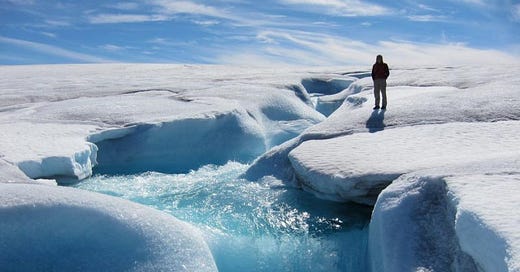



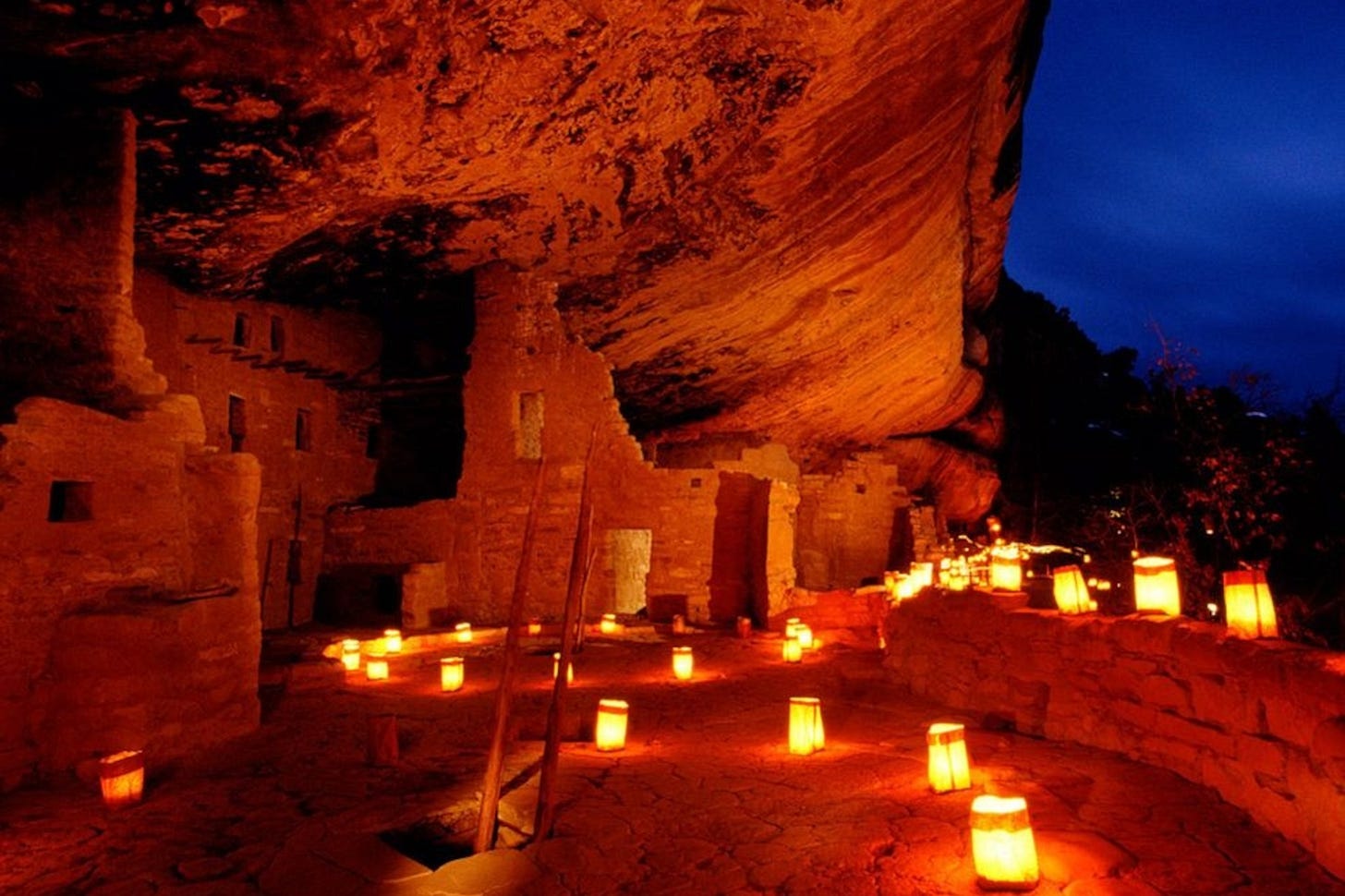
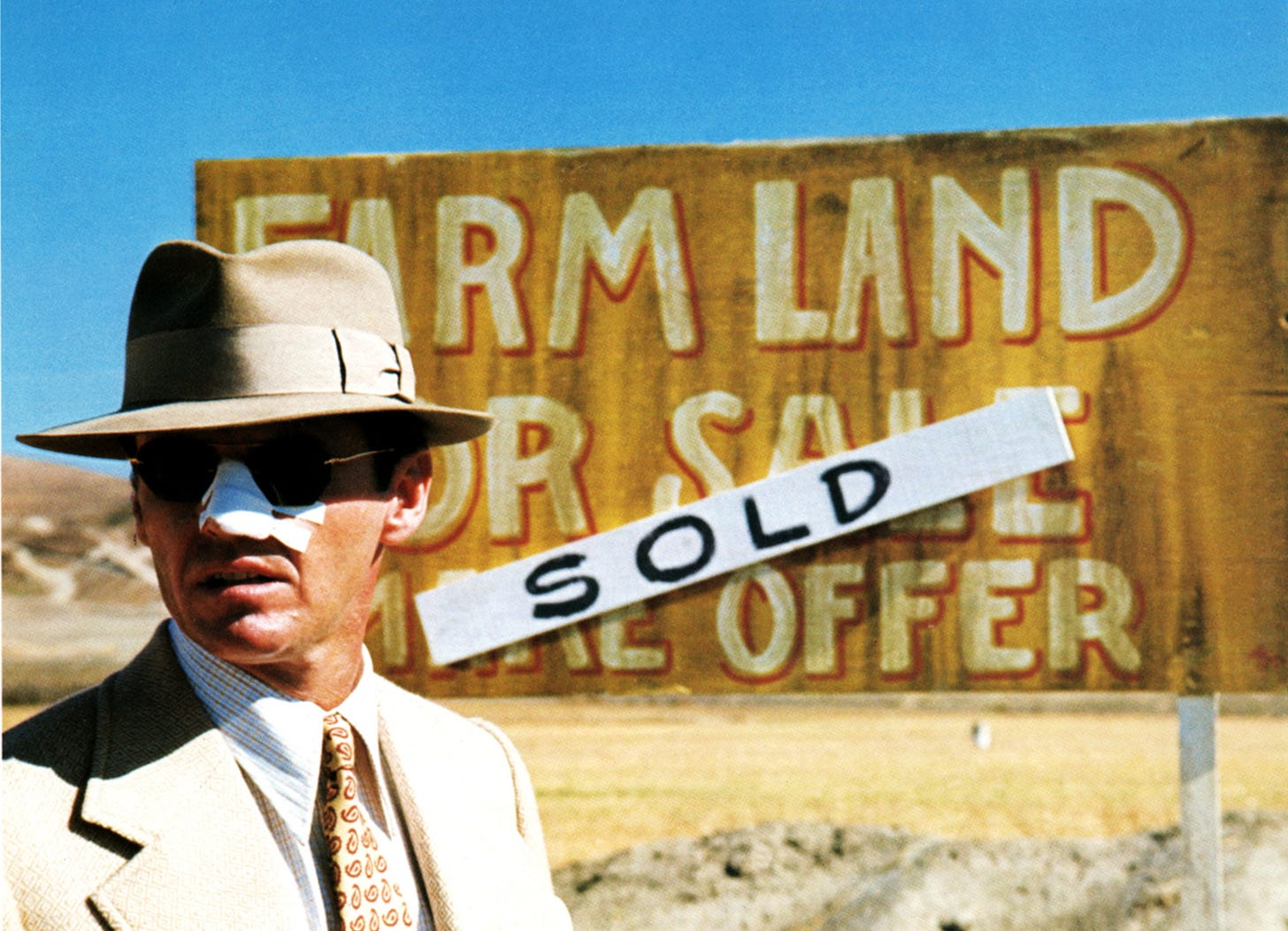
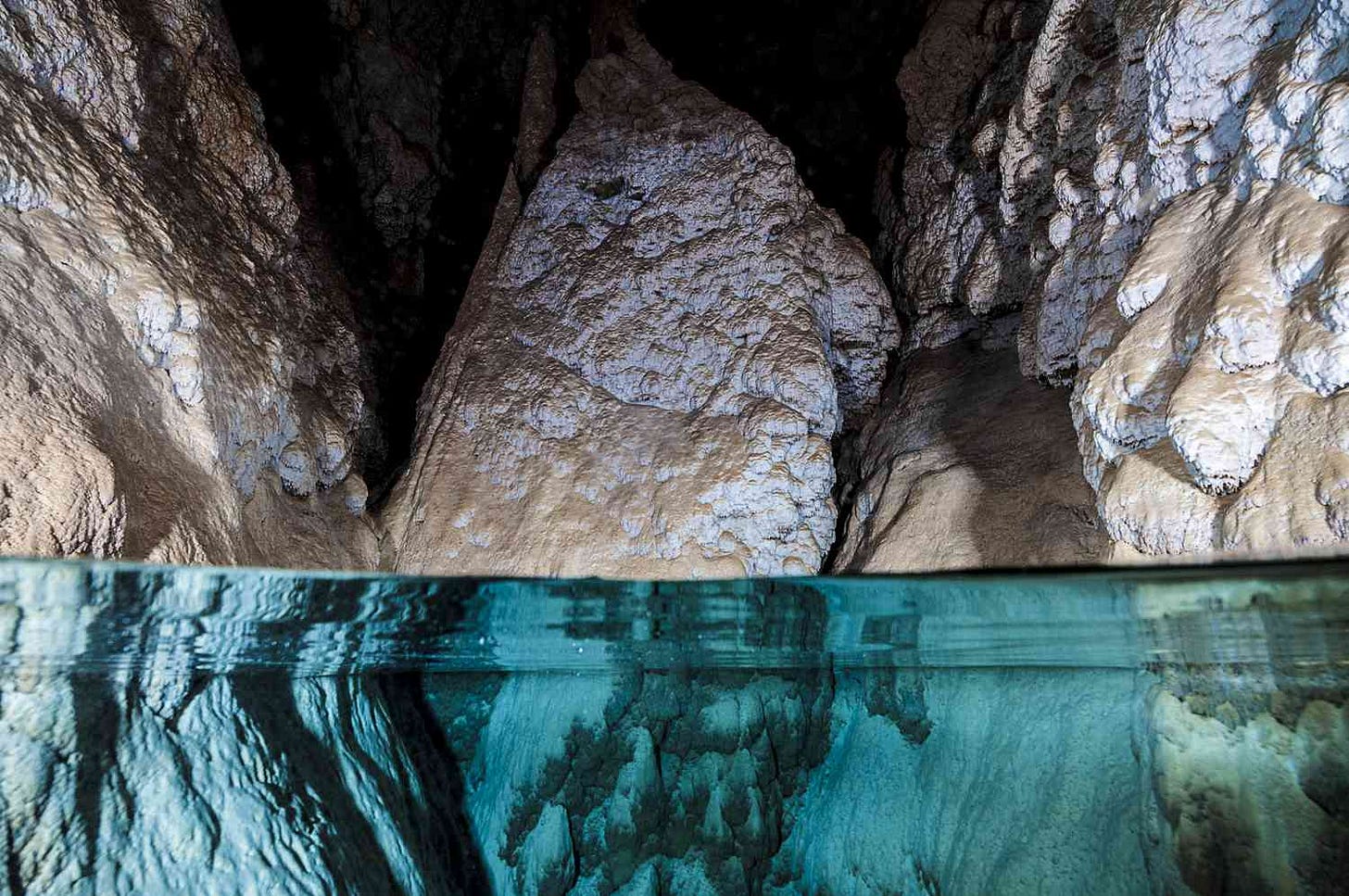
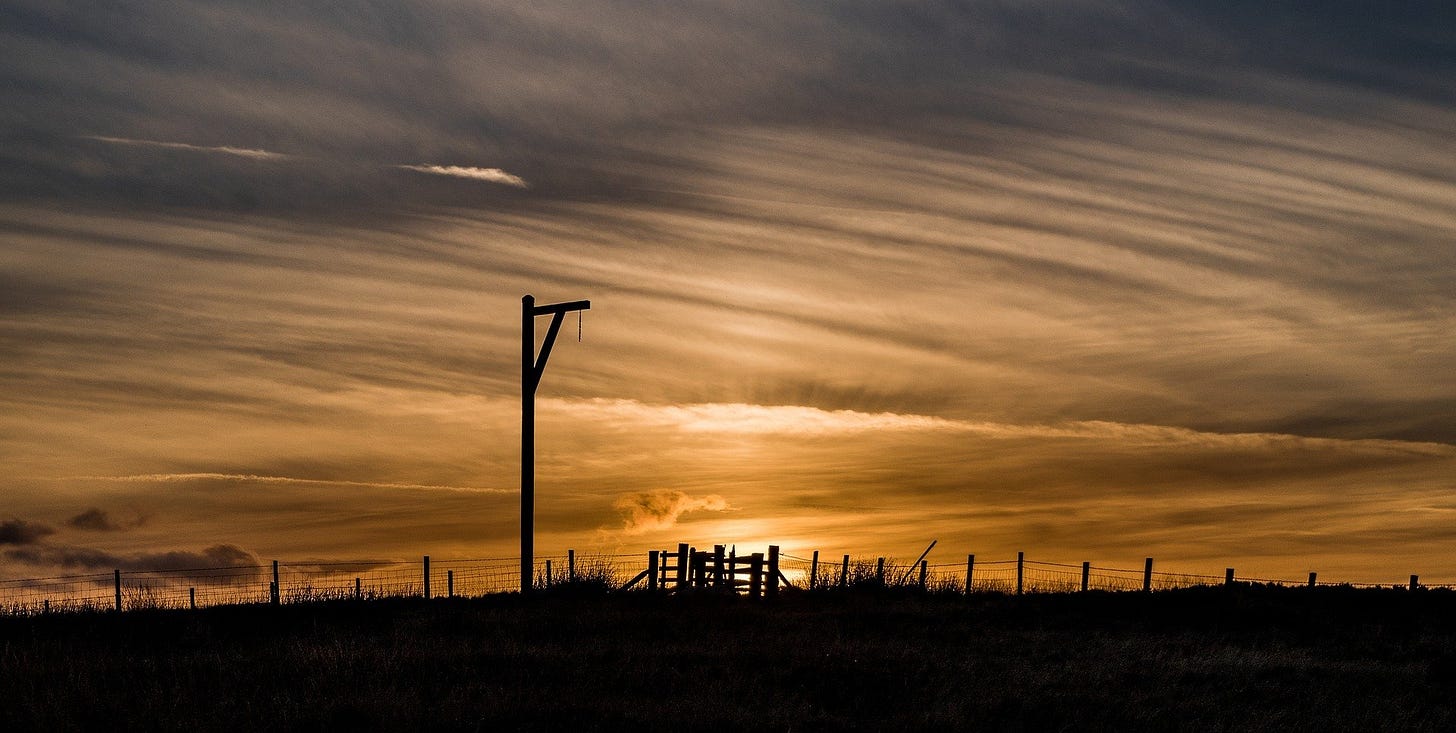
honestly, that was my thesis for that last book Recapture the Rapture. Soul Force or bust. I left the actual conclusions all between the lines, because (as you well know) folks' capacity to shoot sacred cows and digest their grief are limited. But honestly it feels like we're heading for an epochal dip, and the move now is courageous bearing witness to the highwater marks of human civilization, community and consciousness, and embracing Joanna Macy's "We the People of the Passage" notion. Build life boats now, that become star arks later. It's like a three wave hold down set is coming in the ocean and we need to duck dive, not panic, catch breaths where we can, and look for the lull on the other side of the beat down.
Hi Jamie,
I don't know if you read my book, "How Soon Is Now", but essentially it is obvious to me that this is an initiatory threshold for humanity as a whole. To survive, we will have to shift from thinking of ourselves as "I" beings to understanding ourselves as "we" beings (interdependent). Instead of operating out of self-interest, we will have to operate, at every moment in our daily lives, out of collective interest -- care for our human species and for the local and planetary ecology. In fact, this is how truly functional indigenous communities understand themselves and how they deal with their surrounding ecology.
The result of my various psychedelic initiations described in my first books was that, for a long time, I stopped conceiving of myself as important or special, except in how I could leverage my gifts and position/connections to try to assist the greater awakening / transformation process. This led me to start a web magazine for consciousness (we published 1,000+ writers) and The Evolver Network, where we provided a template for local communities to self-organize around a new paradigm of consciousness, shamanism, local economy, permaculture, etc. I stopped my own writing career and threw everything I could into this effort to build a "movement of movements:" We were also promoting MAPS (early days), Transition Town, and other synergetic movements with our vision.
It was horribly difficult - I was also subject to so many attacks and projections, while having no financial resources. Finally I cracked under the pressure. I truly learned how trapped we are in hyper-individualism and Capitalism, always forced to fight for ourselves (even Substack is an example of this, rather than having a magazine or movement where we work with others, now we all write our own little fragmented things with no community cohesion, adding to the problem).
I believe that Capitalism and hyper-individualism will not survive this emergency, this initiatory crisis. But it is fairly clear it is going to have to go an extreme level -- it is possible, if not likely, or even inevitable that we will go extinct. This could happen faster than most might imagine (10 - 30 years ish). We should do what we can to try to find a different option from extinction, but that will require a breaking free of the Capitalist structure and repurposing tools like social networks and AI to build something like the resource-based economy that Jacques Fresco or Buckminster Fuller proposed.
These are a few excerpt from How Soon Is Now, where I tried to define a pathway beyond this current civilization and, also, explored how we could get there, using the tools we have now:
"We can think of our current civilization – its technical and socio-political infrastructure, its ideology and beliefs – as an operating system, much like the software that runs our computers. Now we need to reboot and install a new system software. ...
"The study of biological evolution – the history of life on Earth – reveals an inveterate tendency towards greater levels of cooperation, coordination and symbiosis. This idea may seem surprising at first. As part of the paradigm we inherited – the one we are now leaving behind – many thinkers and scientists placed their focus, instead, on the competitive, aggressive and destructive aspects of nature. This view of biology as a constant struggle for life meshed perfectly with the predatory economic mode of capitalism. This idea has now been superseded by a new view of life as an intricately networked phenomenon, where organisms support each other far more than they compete. ...
According to biologist Lynn Margulis, the author of Microcosmos, who developed the Gaia hypothesis with scientist James Lovelock, ‘The trip from greedy gluttony, from instant satisfaction to long-term mutualism, has been made many times in the microcosm. While destructive species may come and go, cooperation itself increases through time.’ ...
"In Non-Zero: The Logic of Human Destiny, Robert Wright noted that humans keep developing increasingly larger and more complex forms of social organization – from the small tribe to the city-state, from national governments today, to extra-national bodies like the United Nations and the European Union. For Wright, this suggests an eventual transition to global government. I look at this transition differently, believing that we will eventually transcend national governments by establishing a harmonic planetary orchestration, where local communities will function like the cells and organs in an efficient, self-regulating body. ...
"Over the last 60,000 years, since leaving Africa, the human species has developed language and culture, increasing in numbers, slowly at first, as we spread ourselves across the surface of the world. For most of that time, we lived as small tribes of hunter-gatherers. Around 10,000 years ago, we began growing crops, building cities and launching empires. Over the last few centuries, our species discovered steam power, electricity, coal, oil, mechanical technology and industry. We split the atom and beached on the moon.
As its science and technologies advanced, the modern West constructed a new social model based on conspicuous consumption and planned obsolescence. We exported this experimental way of life across the world. In a short span of time, because of our capacity to exploit energy from fossil fuels – one barrel of oil holds the equivalent of 23,200 hours of manpower – humans went from biospheric nonentity to the catalysts of a geological event. The crisis confronting us is the result of what might prove to be our very short-lived success as a species.
As modern society became increasingly severed from nature, our science-based culture propagated an ideology of materialism, dismissing any mystical or religious belief system as antiquated and false. We rejected the natural, the feminine and the intuitive, replacing them with the masculine ideals of order, logic and rationality. Faith in science and technology replaced religion for many people.
When we fully accept and realize that this crisis is our invitation to undergo a collective metamorphosis – to establish something much better than we have now – then we can find the will and courage to handle the distressing specifics. Deepening global crisis is going to force transformation, one way or another. The best thing we can do is seize this chance to leverage a mass awakening. "